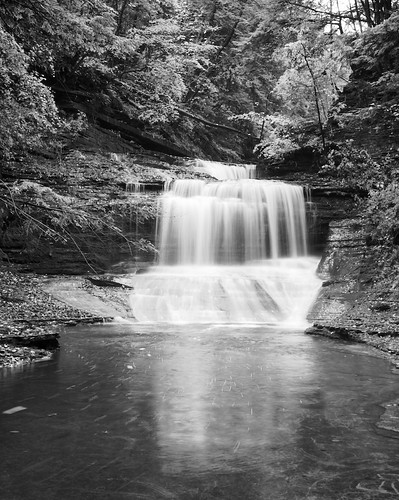
© 2009 Simon Hucko
Ever wonder why your waterfall photos don't have that same dreamy, smooth look that you see in professional photographs? The trick is time. Long exposures work wonders with moving water, making soft cottony clouds out of the foam and spray. The good news? This effect is very easy to get with a minimal amount of special equipment.
You will need:
- Moving water of some sort
- Camera with aperture control
- Tripod
- Cable release or remote for your camera (optional, but it helps)
- Neutral Density (ND) filter for your lens (may be optional, depending on conditions, but highly recommended)
Set up your camera on your tripod. Frame your shot. Drop your ISO to its lowest setting. Close down your aperture to the f/11-f/22 range. Check your exposure time, aiming for a second or more. If it's too bright for you to get a long exposure, time to start thinking about neutral density filters (more below). Because it was pretty dark in the gorge, I was able to get a 1 second exposure at f/22 at ISO 200 (my camera's lowest ISO) without an ND filter, but it only could have helped the image. A cable release or remote will help to reduce camera shake, resulting in a sharper image.
A neutral density filter essentially acts as sunglasses for your camera, reducing the amount of light that enters the lens. (Neutral density means that it blocks all wavelengths of light equally and won't introduce a color cast to your photo.) They come in many strengths, from 1 or 2 stops up to 8 or so. There are two primary uses for a neutral density filter - the first is to be able to use a larger aperture in bright conditions (important when shooting with a flash and worrying about sync speed or shooting video), and the second is to extend exposure time for waterfalls, clouds, etc.
If you're using a point n shoot, you can actually use your sunglasses as a makeshift filter. Bonus points if they're polarized. This doesn't work with SLR lenses, so you're going to have to purchase one. I recommend shelling out for a good quality multi-coated glass filter, as anything else will just degrade your image quality and you won't be happy with the results.
Next time you go hiking around, bring your tripod along and impress everyone with your silky smooth waterfalls. It's worth the hassle.
~S
[title of blog] on flickr
![[title of blog]](https://blogger.googleusercontent.com/img/b/R29vZ2xl/AVvXsEhJ8bvx_9_zOAREbXcrJRML7aVvJMbb90IYYYuyti384jeZHYQ9t8MK6_Kpt_1P4-pZw-QfF9kh4Sqci0vbopzLme862PPhuyPJcc7pRLUW1K1aNzts5YzuXIhgonq66MpjJCqfiWtfwUw/s1600-r/waterfall.png)




While you're at it - take some long exposure close-up shots of the water. You'll see some very interesting shapes and textures appear. And, with that ND filter, you can stop down the lens and get great depth-of-field.
ReplyDelete